Unit 4 Natural disasters Listening and Talking 课件(15页) 2024-2025学年高一英语人教版(2019)必修第一册
文档属性
| 名称 | Unit 4 Natural disasters Listening and Talking 课件(15页) 2024-2025学年高一英语人教版(2019)必修第一册 |
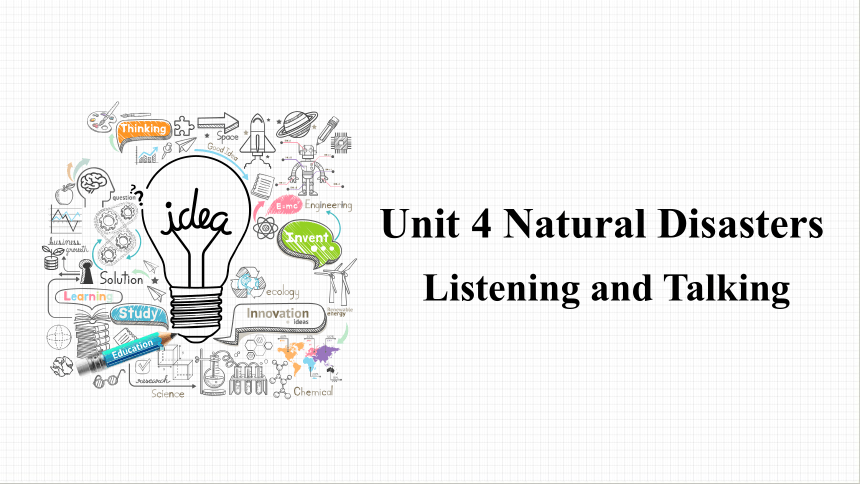
|
|
| 格式 | pptx | ||
| 文件大小 | 8.7MB | ||
| 资源类型 | 教案 | ||
| 版本资源 | 人教版(2019) | ||
| 科目 | 英语 | ||
| 更新时间 | 2024-10-09 16:24:34 | ||
图片预览

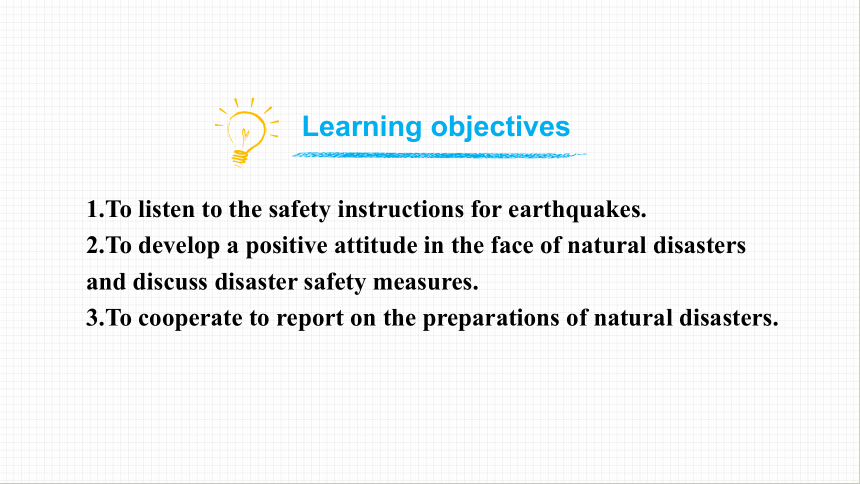
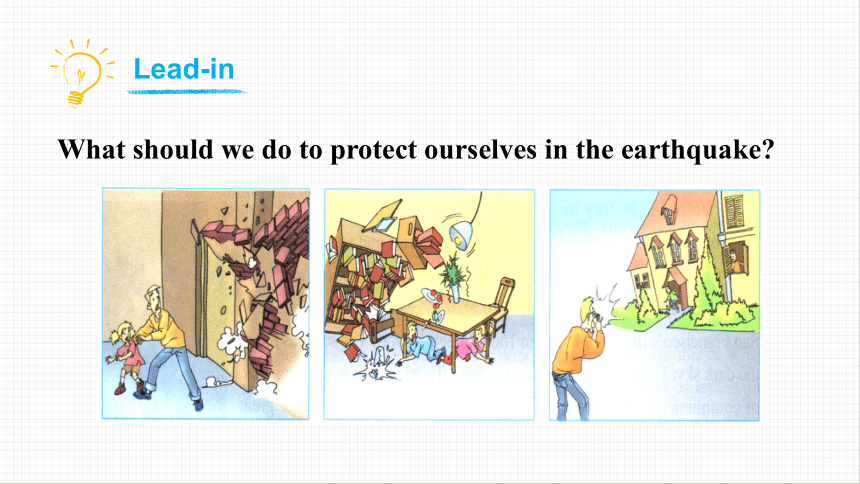
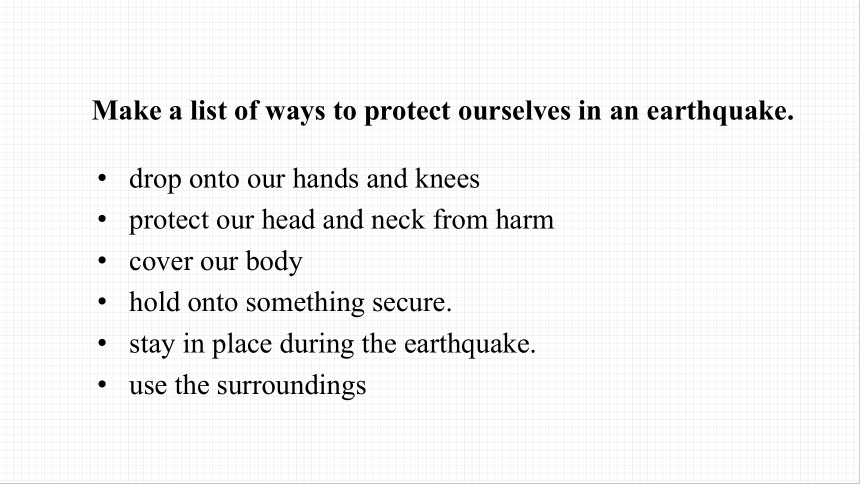
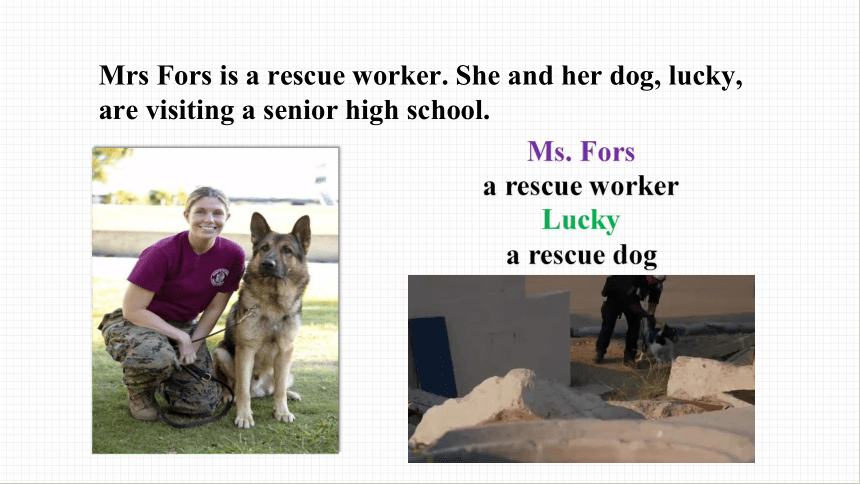
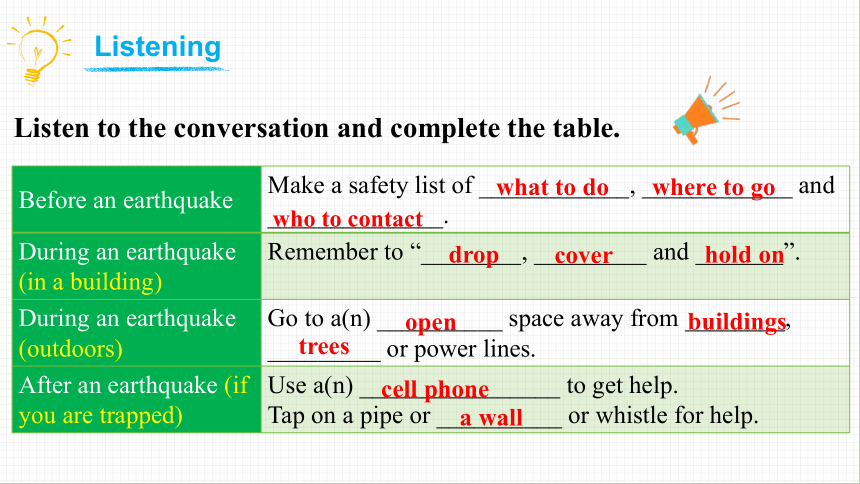
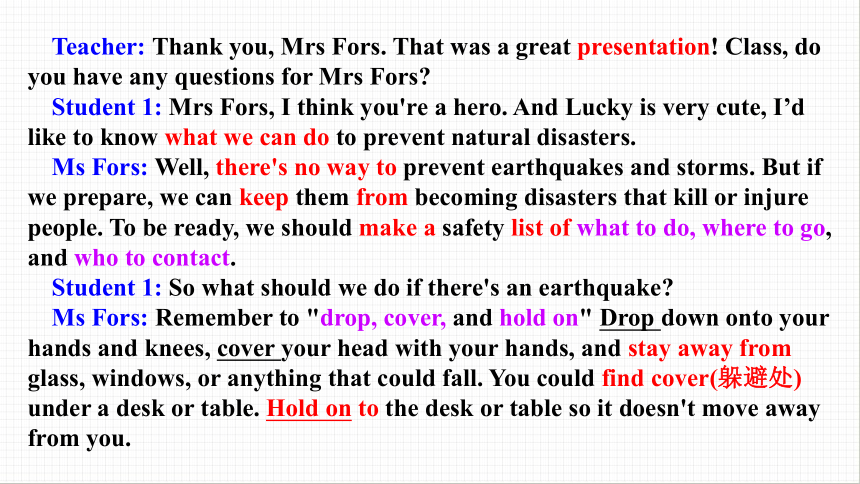
文档简介
(共15张PPT)
Listening and Talking
Unit 4 Natural Disasters
Learning objectives
1.To listen to the safety instructions for earthquakes.
2.To develop a positive attitude in the face of natural disasters and discuss disaster safety measures.
3.To cooperate to report on the preparations of natural disasters.
What should we do to protect ourselves in the earthquake
Lead-in
Make a list of ways to protect ourselves in an earthquake.
drop onto our hands and knees
protect our head and neck from harm
cover our body
hold onto something secure.
stay in place during the earthquake.
use the surroundings
Ms. Fors
a rescue worker
Lucky
a rescue dog
Mrs Fors is a rescue worker. She and her dog, lucky, are visiting a senior high school.
Listen to the conversation and complete the table.
Before an earthquake Make a safety list of ____________, ____________ and ______________.
During an earthquake (in a building) Remember to “________, _________ and _______”.
During an earthquake (outdoors) Go to a(n) __________ space away from ________, _________ or power lines.
After an earthquake (if you are trapped) Use a(n) ________________ to get help.
Tap on a pipe or __________ or whistle for help.
what to do
where to go
who to contact
drop
cover
hold on
open
buildings
trees
cell phone
a wall
Listening
Teacher: Thank you, Mrs Fors. That was a great presentation! Class, do you have any questions for Mrs Fors
Student 1: Mrs Fors, I think you're a hero. And Lucky is very cute, I’d like to know what we can do to prevent natural disasters.
Ms Fors: Well, there's no way to prevent earthquakes and storms. But if we prepare, we can keep them from becoming disasters that kill or injure people. To be ready, we should make a safety list of what to do, where to go, and who to contact.
Student 1: So what should we do if there's an earthquake
Ms Fors: Remember to "drop, cover, and hold on" Drop down onto your hands and knees, cover your head with your hands, and stay away from glass, windows, or anything that could fall. You could find cover(躲避处) under a desk or table. Hold on to the desk or table so it doesn't move away from you.
Teacher: What should we do if we're outside when an earthquake happens Ms Fors: Go to an open space away from buildings, trees, or power lines.
Student 2: And what about after an earthquake Ms Fors: Well, if you' re trapped, you can use a cell phone to call or text for help. You can also tap on a pipe or a wall, or whistle for help. That way Lucky and I can find you!Student 2: I have a question for Lucky. Do you like being a rescue dog Ms Fors: Lucky, what do you sayTeacher: I think he says he's a lucky dog.
Choose a disaster and prepare a list of safety instructions.
tornado tsunami earthquake wildfire flood
Talking
Choose a disaster and prepare a list of safety instructions.
First / First of all, you should ... Cover your ... Call an emergency number.
Stay calm. Listen to the news. Stay away from ...
Don’t drive or walk outside. Move to a safe place. Make sure ...
Collect water and food if you can ... Finally ... Stay indoors.
Look at the emergency supplies below. Discuss with a partner what else you would add.
Water and food for three days
radio
flashlight
whistle
First aid kit
Packing an Emergency Kit .
Pack a 3-day supply of nonperishable food and water. Choose food items with a long shelf life, such as canned goods and packaged pantry items. Choose items that don’t require refrigeration, but also those that require little cooking in case you don’t have power due to a disaster. Store 1 gallon (3.8 L) of water per person (and per pet) per day.
Include clothing, shoes, and toiletries. Pack a 3-day supply of clothing (including multiple layers), socks, and an extra pair of shoes for each member of the family. Toiletries, like soap, shampoo, feminine products, toilet paper, toothbrushes, toothpaste, and deodorant should also be included. Add diapers and wipes if you have small children.
Packing an Emergency Kit .
Add shelter and safety supplies. Pack emergency blankets, sleeping bags, and a tent or two in case you can’t stay in your home. A multipurpose tool (like a knife / file / pliers …), and a whistle would also be handy to have in your kit.
Pack electronics and batteries. Include several flashlights, an AM / FM radio, and extra batteries. You may also want to include a prepaid cell phone with a charger in case your landline or cell phone doesn’t work during a natural disaster.
Packing an Emergency Kit .
Include medicine and a first aid kit. Prescription and over-the-counter medicines should be included in your kit. Add a basic first aid kit containing instant ice packs, bandages, antiseptic ointment, scissors, tape, a suture kit, and so on. Pack extra glasses or contact lenses and solution, and any other medical supplies that may be needed, like a cane or hearing aids with extra batteries.
Report to the class the safety instructions you listed and then explain what emergency supplies people should keep on hand.
If you find yourself in danger from a forest fire, first of all, stay calm. Cover your face with... Then go to a safer place if you can ....
Now our emergency supplies, we would suggest always having on hand enough water and food for three days, a radio, ....
Example
Listening and Talking
Unit 4 Natural Disasters
Learning objectives
1.To listen to the safety instructions for earthquakes.
2.To develop a positive attitude in the face of natural disasters and discuss disaster safety measures.
3.To cooperate to report on the preparations of natural disasters.
What should we do to protect ourselves in the earthquake
Lead-in
Make a list of ways to protect ourselves in an earthquake.
drop onto our hands and knees
protect our head and neck from harm
cover our body
hold onto something secure.
stay in place during the earthquake.
use the surroundings
Ms. Fors
a rescue worker
Lucky
a rescue dog
Mrs Fors is a rescue worker. She and her dog, lucky, are visiting a senior high school.
Listen to the conversation and complete the table.
Before an earthquake Make a safety list of ____________, ____________ and ______________.
During an earthquake (in a building) Remember to “________, _________ and _______”.
During an earthquake (outdoors) Go to a(n) __________ space away from ________, _________ or power lines.
After an earthquake (if you are trapped) Use a(n) ________________ to get help.
Tap on a pipe or __________ or whistle for help.
what to do
where to go
who to contact
drop
cover
hold on
open
buildings
trees
cell phone
a wall
Listening
Teacher: Thank you, Mrs Fors. That was a great presentation! Class, do you have any questions for Mrs Fors
Student 1: Mrs Fors, I think you're a hero. And Lucky is very cute, I’d like to know what we can do to prevent natural disasters.
Ms Fors: Well, there's no way to prevent earthquakes and storms. But if we prepare, we can keep them from becoming disasters that kill or injure people. To be ready, we should make a safety list of what to do, where to go, and who to contact.
Student 1: So what should we do if there's an earthquake
Ms Fors: Remember to "drop, cover, and hold on" Drop down onto your hands and knees, cover your head with your hands, and stay away from glass, windows, or anything that could fall. You could find cover(躲避处) under a desk or table. Hold on to the desk or table so it doesn't move away from you.
Teacher: What should we do if we're outside when an earthquake happens Ms Fors: Go to an open space away from buildings, trees, or power lines.
Student 2: And what about after an earthquake Ms Fors: Well, if you' re trapped, you can use a cell phone to call or text for help. You can also tap on a pipe or a wall, or whistle for help. That way Lucky and I can find you!Student 2: I have a question for Lucky. Do you like being a rescue dog Ms Fors: Lucky, what do you say
Choose a disaster and prepare a list of safety instructions.
tornado tsunami earthquake wildfire flood
Talking
Choose a disaster and prepare a list of safety instructions.
First / First of all, you should ... Cover your ... Call an emergency number.
Stay calm. Listen to the news. Stay away from ...
Don’t drive or walk outside. Move to a safe place. Make sure ...
Collect water and food if you can ... Finally ... Stay indoors.
Look at the emergency supplies below. Discuss with a partner what else you would add.
Water and food for three days
radio
flashlight
whistle
First aid kit
Packing an Emergency Kit .
Pack a 3-day supply of nonperishable food and water. Choose food items with a long shelf life, such as canned goods and packaged pantry items. Choose items that don’t require refrigeration, but also those that require little cooking in case you don’t have power due to a disaster. Store 1 gallon (3.8 L) of water per person (and per pet) per day.
Include clothing, shoes, and toiletries. Pack a 3-day supply of clothing (including multiple layers), socks, and an extra pair of shoes for each member of the family. Toiletries, like soap, shampoo, feminine products, toilet paper, toothbrushes, toothpaste, and deodorant should also be included. Add diapers and wipes if you have small children.
Packing an Emergency Kit .
Add shelter and safety supplies. Pack emergency blankets, sleeping bags, and a tent or two in case you can’t stay in your home. A multipurpose tool (like a knife / file / pliers …), and a whistle would also be handy to have in your kit.
Pack electronics and batteries. Include several flashlights, an AM / FM radio, and extra batteries. You may also want to include a prepaid cell phone with a charger in case your landline or cell phone doesn’t work during a natural disaster.
Packing an Emergency Kit .
Include medicine and a first aid kit. Prescription and over-the-counter medicines should be included in your kit. Add a basic first aid kit containing instant ice packs, bandages, antiseptic ointment, scissors, tape, a suture kit, and so on. Pack extra glasses or contact lenses and solution, and any other medical supplies that may be needed, like a cane or hearing aids with extra batteries.
Report to the class the safety instructions you listed and then explain what emergency supplies people should keep on hand.
If you find yourself in danger from a forest fire, first of all, stay calm. Cover your face with... Then go to a safer place if you can ....
Now our emergency supplies, we would suggest always having on hand enough water and food for three days, a radio, ....
Example
